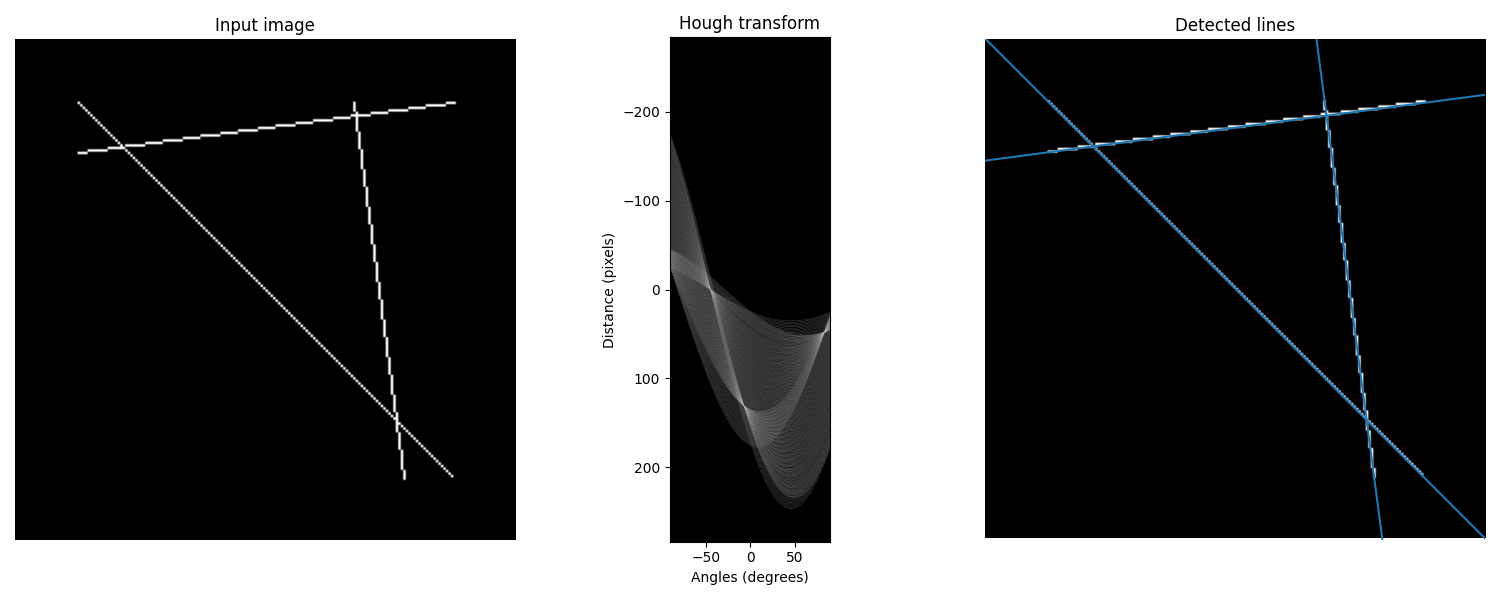备注
转到末尾 以下载完整示例代码。或在您的浏览器中通过 Binder 运行此示例。
直线霍夫变换#
Hough变换在其最简单的形式中是一种检测直线的方法 [1]。
在下面的例子中,我们构建了一个带有线条交叉的图像。然后我们使用 Hough 变换 来探索可能穿过图像的直线的参数空间。
算法概述#
通常,直线被参数化为 \(y = mx + c\),其中包含斜率 \(m\) 和 y 轴截距 c。然而,这意味着对于垂直线,\(m\) 会趋向无穷大。因此,我们改为构建一条垂直于该直线并指向原点的线段。该直线由该线段的长度 \(r\) 和它与 x 轴形成的角度 \(\theta\) 表示。
Hough变换构建了一个表示参数空间的直方图数组(即一个 \(M imes N\) 矩阵,其中 \(M\) 是半径的不同值,\(N\) 是 \(\theta\) 的不同值)。对于每个参数组合,\(r\) 和 \(\theta\),我们随后计算输入图像中非零像素的数量,这些像素会落在相应直线的附近,并在位置 \((r, \theta)\) 处适当增加数组。
我们可以认为每个非零像素“投票”给潜在的线条候选者。结果直方图中的局部最大值表示最可能的线条的参数。在我们的例子中,最大值出现在45度和135度,对应于每条线的法向量角度。
另一种方法是渐进概率霍夫变换 [2]。它基于使用投票点的随机子集可以很好地近似实际结果的假设,并且可以通过沿着连接的组件行走来在投票过程中提取线条。这返回每个线段的起点和终点,这是有用的。
函数 probabilistic_hough 有三个参数:应用于Hough累加器的一般阈值、最小线长度以及影响线合并的线间隙。在下面的示例中,我们找到长度大于10且间隙小于3像素的线。
参考文献#
线霍夫变换#
import numpy as np
from skimage.transform import hough_line, hough_line_peaks
from skimage.feature import canny
from skimage.draw import line as draw_line
from skimage import data
import matplotlib.pyplot as plt
from matplotlib import cm
# Constructing test image
image = np.zeros((200, 200))
idx = np.arange(25, 175)
image[idx, idx] = 255
image[draw_line(45, 25, 25, 175)] = 255
image[draw_line(25, 135, 175, 155)] = 255
# Classic straight-line Hough transform
# Set a precision of 0.5 degree.
tested_angles = np.linspace(-np.pi / 2, np.pi / 2, 360, endpoint=False)
h, theta, d = hough_line(image, theta=tested_angles)
# Generating figure 1
fig, axes = plt.subplots(1, 3, figsize=(15, 6))
ax = axes.ravel()
ax[0].imshow(image, cmap=cm.gray)
ax[0].set_title('Input image')
ax[0].set_axis_off()
angle_step = 0.5 * np.diff(theta).mean()
d_step = 0.5 * np.diff(d).mean()
bounds = [
np.rad2deg(theta[0] - angle_step),
np.rad2deg(theta[-1] + angle_step),
d[-1] + d_step,
d[0] - d_step,
]
ax[1].imshow(np.log(1 + h), extent=bounds, cmap=cm.gray, aspect=1 / 1.5)
ax[1].set_title('Hough transform')
ax[1].set_xlabel('Angles (degrees)')
ax[1].set_ylabel('Distance (pixels)')
ax[1].axis('image')
ax[2].imshow(image, cmap=cm.gray)
ax[2].set_ylim((image.shape[0], 0))
ax[2].set_axis_off()
ax[2].set_title('Detected lines')
for _, angle, dist in zip(*hough_line_peaks(h, theta, d)):
(x0, y0) = dist * np.array([np.cos(angle), np.sin(angle)])
ax[2].axline((x0, y0), slope=np.tan(angle + np.pi / 2))
plt.tight_layout()
plt.show()

概率霍夫变换#
from skimage.transform import probabilistic_hough_line
# Line finding using the Probabilistic Hough Transform
image = data.camera()
edges = canny(image, 2, 1, 25)
lines = probabilistic_hough_line(edges, threshold=10, line_length=5, line_gap=3)
# Generating figure 2
fig, axes = plt.subplots(1, 3, figsize=(15, 5), sharex=True, sharey=True)
ax = axes.ravel()
ax[0].imshow(image, cmap=cm.gray)
ax[0].set_title('Input image')
ax[1].imshow(edges, cmap=cm.gray)
ax[1].set_title('Canny edges')
ax[2].imshow(edges * 0)
for line in lines:
p0, p1 = line
ax[2].plot((p0[0], p1[0]), (p0[1], p1[1]))
ax[2].set_xlim((0, image.shape[1]))
ax[2].set_ylim((image.shape[0], 0))
ax[2].set_title('Probabilistic Hough')
for a in ax:
a.set_axis_off()
plt.tight_layout()
plt.show()

脚本总运行时间: (0 分钟 0.970 秒)
